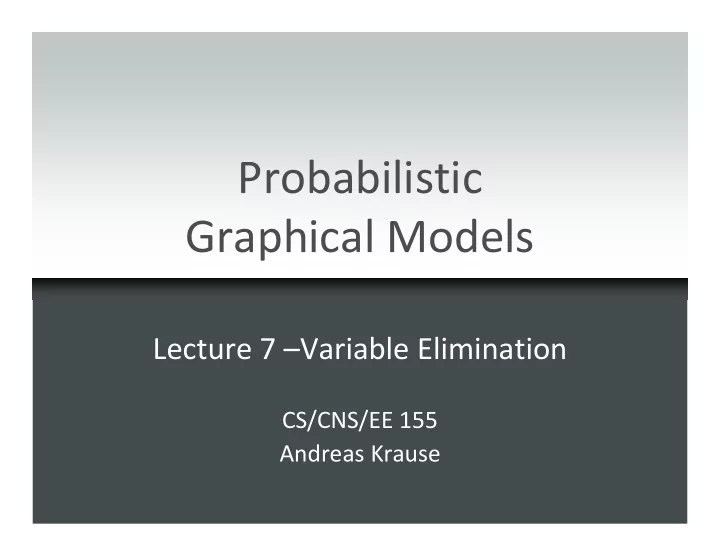

Probabilistic Graphical Models Lecture 7 –Variable Elimination CS/CNS/EE 155 Andreas Krause
Announcements Homework 1 due today in class Will get back to you soon with feedback on project proposals. 2
Key questions How do we specify distributions that satisfy particular independence properties? � Representation How can we identify independence properties present in data? � Learning How can we exploit independence properties for efficient computation? � Inference 3
Bayesian network inference Compact representation of distributions over large number of variables (Often) allows efficient exact inference (computing marginals, etc.) HailFinder 56 vars ~ 3 states each � ~10 26 terms > 10.000 years on Top supercomputers JavaBayes applet 4
Typical queries: Conditional distribution Compute distribution of some E B variables given values for others A J M 5
Typical queries: Maxizimization MPE (Most probable explanation): E B Given values for some vars, compute most likely assignment to all remaining vars A J M MAP (Maximum a posteriori): Compute most likely assignment to some variables 6
Hardness of inference for general BNs Computing conditional distributions: Exact solution: #P-complete Approximate solution: Maximization: MPE: NP-complete MAP: NP PP -complete Inference in general BNs is really hard � Is all hope lost? 7
Inference Can exploit structure (conditional independence) to efficiently perform exact inference in many practical situations For BNs where exact inference is not possible, can use algorithms for approximate inference (later this term) 8
Potential for savings: Variable elimination! X 1 X 2 X 3 X 4 X 5 Intermediate solutions are distributions on fewer variables! 9
Variable elimination algorithm Given BN and Query P(X | E = e ) Remove irrelevant variables for {X, e } Choose an ordering of X 1 ,…,X n Set up initial factors: f i = P(X i | Pa i ) For i =1:n, X i ∉ {X, E } Collect all factors f that include X i Generate new factor by marginalizing out X i Add g to set of factors Renormalize P(x, e ) to get P(x | e ) 10
Multiplying factors 11
Marginalizing factors 12
Does the order matter? 13
Variable elimination for polytrees 14
Complexity of variable elimination Tree graphical models Using correct elimination order, factor sizes do not increase! Inference in linear time!! General graphical models Ultimately NP-hard.. Need to understand what happens if there are loops 15
Variable elimination with loops A J M R L 16
Elimination as graph transformation: Moralization Coherence Difficulty Intelligence Grade SAT Letter Job Happy 17
Elimination: Filling edges Coherence Difficulty Intelligence Grade SAT Letter Job Happy 18
Impact of elimination order {C,D,S,I,L,H,J,G} {G,C,D,S,I,L,H,J} Coherence Coherence Difficulty Intelligence Difficulty Intelligence Grade SAT Grade SAT Letter Letter Job Job Happy Happy Different elim. order induce different graphs! 19
Induced graph and VE complexity Theorem : Coherence All factors arising in VE are defined over cliques (fully connected subgraphs) of the Difficulty Intelligence induced graph All maximal cliques of induced graph arise Grade SAT as factors in VE Letter Treewidth for ordering = Size of largest clique of induced graph -1 Job Happy Treewidth of a graph = minimal treewidth under optimal ordering VE exponential in treewidth! 20
Compact representation � small treewidth? 21
Finding the optimal elimination order Theorem : Deciding whether there exists an elimination order with induced with at most K is NP-hard Proof by reduction from MAX-CLIQUE In fact, can find elimination order in time exponential in treewidth Finding optimal ordering as hard as inference… For which graphs can we find optimal elimination order? 22
Finding optimal elimination order For trees can find optimal ordering (saw before) A graph is called chordal if every cycle of length \geq 4 has a chord (an edge between some pair of non- consecutive nodes) Every tree is chordal! Can find optimal elimination ordering for chordal graphs 23
Minimal fill heuristic Unmark all nodes Coherence For i = 1:n Find unmarked node X such that Difficulty Intelligence adding X adds fewest additional edges Grade SAT Set X as i-th var. in ordering Fill in edges added by eliminating X Letter Mark X Job Happy Often very effective! In fact, finds optimal order for chordal graphs! May want to weigh by factor size 24
Maxizimization queries MPE (Most probable explanation): E B Given values for some vars, compute most likely assignment to all remaining vars A J M 25
Variable elimination for MPE X 1 X 2 X 3 X 4 X 5 26
Recovering the MPE X 1 X 2 X 3 X 4 X 5 27
Variable elimination for MPE: Forward pass Given BN and MLE query max P(x_1,…,x_n | E = e ) Choose an ordering of X 1 ,…,X n Set up initial factors: f i = P(X i | Pa i ) For i =1:n, X i ∉ {X, E } Collect all factors f that include X i Generate new factor by maximizing over X i Add g to set of factors 28
Variable elimination for MPE: Backward pass Variables x 1* ,…,x n* will contain MPE For i = n:1, X i ∉ {X, E } Take factors f 1 ,..,f m used when eliminating X i Plug in values x i+1* ,…,x n* into these factors 29
Maximizing factors 30
Summary so far Variable elimination complexity exponential in induced width for elimination ordering Finding optimal ordering is NP-hard Many good heuristics Exact for trees, chordal graphs Ultimately, inference is NP-hard Only difference between cond. prob. queries and MPE is � vs. max Variable elimination building block for many exact and approximate inference techniques 31
Tasks Homework 2 due in class Wednesday Nov 4 32
Recommend
More recommend